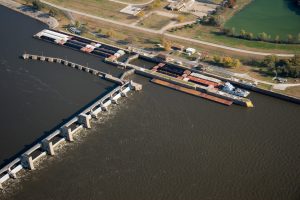[share]
Rivers Issues are Driving New Partnerships
 Over the past several weeks GREDF President, Marcel Wagner and Director of the Quincy Entrepreneurship Center, Charles Bell, have had the opportunity to meet with a number of groups that have the same concerns about the future of river transportation as our organization. Meetings with Department of Transportation officials from Illinois, Iowa and Missouri, agricultural trade groups such as the Illinois Soybean Association and Iowa Soybean Association and a variety of economic development groups have driven the need for the 3 states and others to partner on a focused effort to maintain and upgrade the locks and dams. Just one reason why: At a recent meeting in Iowa the Army Corp of Engineers said that their schedule of upgrades and maintenance is now pushed out to 2090.
Over the past several weeks GREDF President, Marcel Wagner and Director of the Quincy Entrepreneurship Center, Charles Bell, have had the opportunity to meet with a number of groups that have the same concerns about the future of river transportation as our organization. Meetings with Department of Transportation officials from Illinois, Iowa and Missouri, agricultural trade groups such as the Illinois Soybean Association and Iowa Soybean Association and a variety of economic development groups have driven the need for the 3 states and others to partner on a focused effort to maintain and upgrade the locks and dams. Just one reason why: At a recent meeting in Iowa the Army Corp of Engineers said that their schedule of upgrades and maintenance is now pushed out to 2090.
Here are some important statistics about the current state of river issues:
- Of the 27 locks and dams on the upper Mississippi, only 1 is within its 50 year design life, 2 are 20 years past design life, 21 are 30 years past design life and 3 are past the 30 year design life.
- The average age of the upper Mississippi locks is 72 years.
- A single point of failure at any lock shuts down the system.
- Current funding only addresses critical maintenance and emergency repairs. Since 1990 that funding has been cut from $13 billion annually to $7 billion annually.
- Trade growth on the Mississippi will increase by 40% over the next 20 years.
- 1 barge is the equivalent of 70 53-foot semi-trucks and a disruption of river service would cause severe deterioration of roads and bridges and increase road congestion by multiples.
- Barge freight averages $10.67 per ton cost of freight less than road and rail.
A partnership among the Upper Mississippi River states is urging the passage of the 2013 Water Resources and Development Act which is critical to maintaining the current status of our waterways. Congress also needs to address the shortage of funding in the Inland Waterways Trust Fund.
The next step for the partnership is to secure Marine Highway status for the Upper Mississippi Connector, stretching from St. Louis to St. Paul on the Mississippi River. Declaring this Connector a Marine Highway could benefit the region by promoting navigation and economic development. The designation also allows ports and terminals to receive technical assistance from the U.S. Maritime Administration, a part of the U.S. Department of Transportation.
What can you do?
Contact your state and federal elected officials and ask them to make rivers issues a top priority. You can find contact information for your elected officials here: www.usa.gov.


